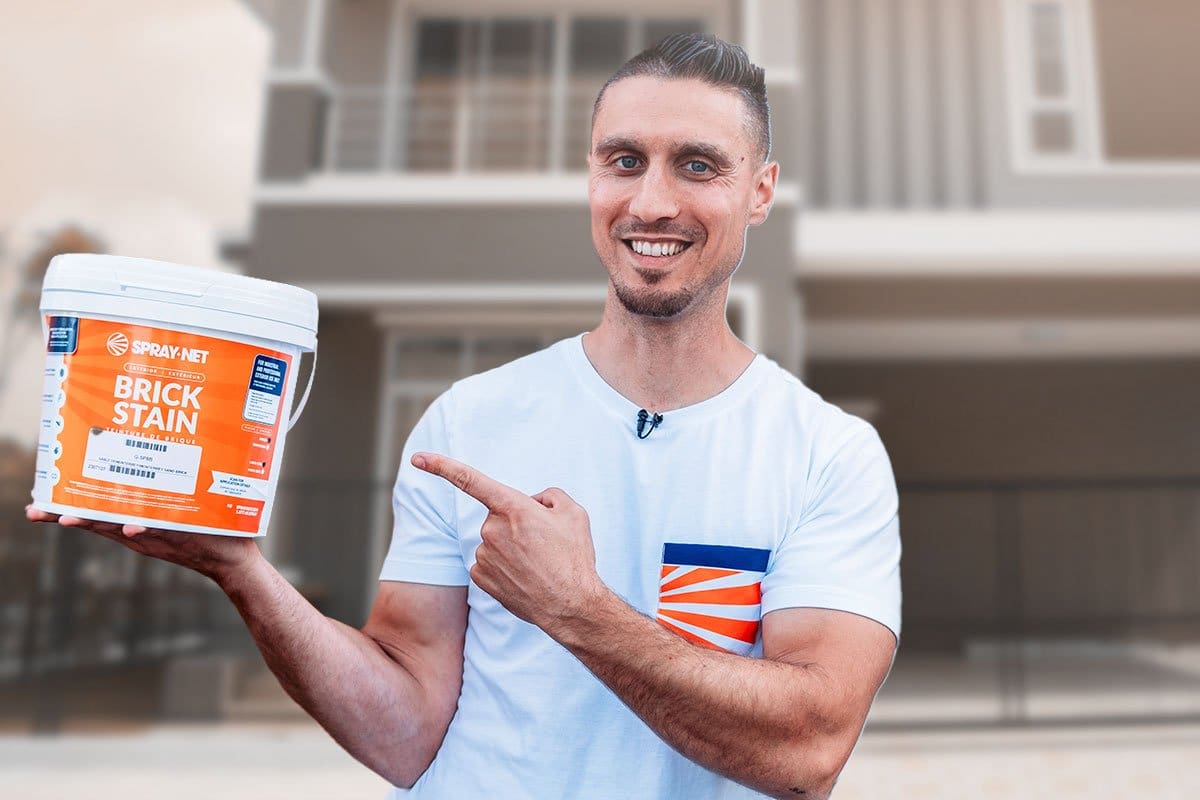Clients pay hefty sums for a good residential painting company. Want to know how to start a painting company and make $10,420 per hour?
We’ll show you how Carmelo Marsala started Spray-Net and makes over $21 million per year. He discusses his painting services, pricing, and how to get painting jobs. Along the way, he shares a bit of his business philosophy.
Read on to learn how to get started in painting from a business owner who has trained more than 117 franchisees to use his patented painting process for roofs, vinyl, and other unique materials.
- Case Study: Spray-Net
- UpFlip exclusive Spray-Net franchise
- Learn about the painting industry
- How to start a painting business
- Step #1. Learn professional house painting skills
- Step #2. Research the market
- Step #3. Create a painting business plan
- Step #4. Consider painting business names
- Step #5. Choose your business structure
- Step #6. Get a painter’s license
- Step #7. Open a business bank account
- Step #8. Get painting business insurance
- Step #9. Establish painting services and prices
- Step #10. Choose your painting equipment
- Step #11. Set up accounting and bookkeeping
- Step #12. Invest in painting business software
- Step #13. Advertise your painting business
- Step #14. Get your first customers
- Step #15. Document everything
- Step #16. Hire subcontractors or employees
- Spray-Net franchise offer
- Painting business influencers
- Painting business resources
- Start your own painting business
Case Study: Spray-Net

Straight out of college, Carmelo became a franchisee for the painting company College Pro. He realized exterior vinyl painting was something that was missing in the industry. He started digging into why and found that the standard paint production process just doesn’t work for vinyl application.
Carmelo started asking why additives weren’t added on site to adjust to weather conditions, and he kept hearing the same thing:
He decided to reimagine the process and formulate his own paint. Spray-Net was born, and today he makes around $21 million per year selling painting franchises and training the franchisees. There are now more than 130 Spray-Net locations in the U.S. and Canada.
Check out our interview with Carmelo below.
If you like how Spray-Net approaches the painting industry, consider our exclusive offer.
UpFlip exclusive Spray-Net franchise
We’ve partnered with Carmelo to offer you an exclusive opportunity to get a Spray-Net franchise and save.
Learn about the painting industry
How much does it cost to start a painting business?

Though car painting and artistic painting can be viable business options, in this guide, we’ll be covering house painting businesses.
Starting a house painting business requires startup costs between $50 and $35,000, depending on the type of painting business and whether you have the tools and equipment to start painting.
Painting companies that need a shop could cost much more than $35K because you’ll need to put a deposit on the space, remodel, and furnish the space. That’s why many people consider starting a painting business from home. Costs will vary based on the region.
The basic painting supplies, like brushes, drop cloths, extension poles, paint trays, and rollers, aren’t that expensive. The main costs will be a vehicle, business formation, and insurance when you first start. You’ll save a lot of money if you already have a vehicle.
Do painting business owners make good money?
Yes, painting business owners can make great money, but it depends.
According to business research firm IBIS World, the average painting company makes about $140K per year with a 6.9% profit margin, which isn’t very good. Successful professional painters can make much more though. Carmelo told us about Spray-Net’s earnings.
That means first-year painting business owners can take home over $100K in net profit. The older franchises are making about 2.5 times that. We came to these numbers by multiplying the revenue by the gross margin and then subtracting 40% (20% for taxes and 20% for additional business costs).
Do painters need to be licensed and insured?

Make sure to ask a licensed attorney about the requirements in your location, but most states require contractors to be licensed and insured. Make sure to register as a contractor if it is required in your location.
At a minimum, you should carry $1M per occurrence or $2M in lifetime general liability insurance to protect against damage done to clients’ property. In addition, you’ll probably need workers’ compensation and commercial automotive insurance.
What equipment do I need to start a painting business?
You’ll want commercial painting equipment when you start a painting company. Some of the equipment you’ll need includes:
- Brushes
- Drop cloths
- Extension poles
- Paint trays
- Rollers
- A truck or van
- Painters tape
Spray-Net has additional painting equipment requirements, including sprayers and mixers, which are necessary to mix and spray the paint on location.
Their painting process is patent protected, so if you want to use their painting equipment you’ll need to buy a Spray-Net franchise.
How to start a painting business

Starting a painting business requires you to:
- Learn professional house painting skills.
- Research the market.
- Create a painting business plan.
- Consider painting business names.
- Choose your business structure.
- Get a painter’s license.
- Open a business bank account.
- Get painting business insurance.
- Establish painting services and prices.
- Choose your painting equipment.
- Set up accounting and bookkeeping.
- Invest in painting business software.
- Advertise your painting business.
- Get your first customers.
- Document everything.
- Hire subcontractors or employees.
Get ready to learn how to start a painting business.
Step #1. Learn professional house painting skills
You’ll need to learn how to paint professionally to avoid making mistakes that cost you time and money. Potential customers expect you to protect their property and don’t want to request touchups after you declare the job done.
Make sure to develop painting skills, like:
- Protecting the space
- Knowledge about acrylic, latex, and oil paints
- Using primers for interior painting (some exceptions apply)
- Properly using paint brushes, rollers, and sprayers
- Scraping, sanding, and patching
- Applying an even coat
- Cutting paint
And don’t forget to always paint a room from top to bottom.
Step #2. Research the market

This article is a good start for understanding the market and financial viability of a painting company. You’ll want to do more research to understand whether a painting business will be successful in your area.
Research the number of local painting businesses and their reputations, pricing, and services. You’ll also want to know how many area homeowners there are, or the number of potential commercial clients.
Understanding how others market their painting companies will help you manage your painting business so you can differentiate your marketing strategy from the rest of the pack.
Step #3. Create a painting business plan
Painting business plans help you, lenders, and your employees understand the company’s values, unique value propositions, and intended operations.
You can make a simple one-page business plan just to help you keep your business on track, or you can create a more extensive business plan for when you apply for business loans.
Carmelo told us:
Learn more in our business plan writing guide.
Step #4. Consider painting business names

You’ll need a professional name for your painting business. Your business name will be how people recognize the business. It should be fun, easy to spell, and identifiable as a painting company.
You should look up your painting company name ideas on the United States Patent and Trademark Office website and other search engines to make sure the business name is available. Then you’ll want to choose your business structure and register your business.
Step #5. Choose your business structure
Painting contractors will need to register their painting business with their Secretary of State and potentially their local government. You have a few business structure options when starting a painting business, but the most common types are a limited liability company or sole proprietorship.
A limited liability company makes your painting business a unique entity (as long you keep your personal and professional finances separate). This prevents you from being personally liable if something occurs within the business. There are also tax benefits to a business being a separate entity.
Meanwhile, a sole proprietorship is a business structure where you and the house painting business are one entity, which means if an accident happens, your personal assets can be taken to reimburse the client or employee.
Learn more in our guide to business structures.
Step #6. Get a painter’s license

Many locations require you to become a licensed painter when starting a painting business.
A painter’s license is just a business license that requires you to prove you have the insurance your area requires you to have. The best insurance to cover everything is often a business owner’s policy, but we’ll discuss insurance more below.
There may be other requirements, including testing or job experience, depending on the location.
Step #7. Open a business bank account
You’ll need a business bank account to keep your personal and business expenses separate. You can choose to get a business bank account from:
- Brick-and-mortar banks: These banks are local to you, have higher probabilities of approving loans, and are easier to deposit cash.
- Online-only business banks: A business owner can benefit from an online bank with lower fees and higher interest rates on savings, but it’s harder to deposit cash and get a loan.
Step #8. Get painting business insurance

A successful painting business needs insurance to protect the business owner, their employees, and their commercial and residential painting clients. You might be wondering, what insurance does a self-employed painter need?
The small business insurance you need when starting a painting business is:
- General liability insurance: This coverage protects you if your painting company accidentally damages or hurts a non-employee. It is typically a $1M per occurrence or $2M for a lifetime policy, but some local governments or commercial clients may require higher limits.
- Workers compensation insurance: You’ll want this in case anyone gets hurt on the job. It will cover their injuries and their wages as long as they weren’t negligent or intoxicated. This is mandatory in nearly every state.
- Unemployment insurance: This insurance protects workers who get laid off. It’s required by law in every state.
- Commercial auto insurance: You’ll need separate car insurance for your business vehicles.
Many of these can be combined into one plan with a business owner’s policy. You can learn more in our business insurance guide.
When you’re ready, we suggest going to Simply Business to get quotes from the largest insurance companies in the world.
Step #9. Establish painting services and prices
At this point, you have a business entity, business license, and insurance. You can operate your own business, but what services are you going to offer, and how will you price painting jobs to establish positive cash flow?
To give you an idea, we’ll cover Spray-Net’s services and pricing.
Spray-Net offers three main services:
- Exterior painting: They have spray coatings that work on exterior vinyl, stucco, brick, and doors or glass windows.
- Kitchen cabinet painting: Spray-Net offers indoor services, as well, such as cabinet painting.
- Roof re-granulating: I wouldn’t think to hire painting contractors if my roof has issues, but Spray-Net paints roofs and says the painting job adds 15 years to the life of the roof. Check out their explainer video below.
They price each job either by the square foot or the number of cabinets. They also provide an online estimator so potential customers can get an idea of how much the job will cost.
Their average ticket for a painting job is $5,815, which puts it between the cost of replacing and standard repainting. They offer warranties nearly three times longer than most residential painting companies.
Before you start a new painting business, you should probably look at their professional painting work. You might want to consider their franchise business model to make more money painting houses.
Step #10. Choose your painting equipment

As we stated earlier, when you start a painting company, you’ll need:
- Drop cloths
- Extension poles
- Paint trays
- Rollers
- Truck or van
- Painters tape
- Sprayers
- Mixers
- Paint brushes
- Booties for your shoes
- Respirators
You can get these at Home Depot, Lowe’s, or any paint supply store.
Step #11. Set up accounting and bookkeeping
You’ll need a good accountant and bookkeeper to keep your financials in order and help you comply with taxes. Ask other business owners in your area who they prefer.
Step #12. Invest in painting business software

You’ll need software to run your own painting company. Here’s some of the essential software:
- Website: You’ll want to build a website. Which means you’ll need a domain name from somewhere like GoDaddy.
- Customer relationship management (CRM) system: You’ll also need to have a CRM to manage all your customers. Small business owners tend to like Jobber or Housecall Pro.
- Accounting software: You’ll want to get QuickBooks to manage your small business’s finances and payroll. A small business owner can make themselves an employee to receive a weekly paycheck.
- Payroll processor: A modern small business will need to accept credit cards, which means you’ll need a payment processor like Square.
Step #13. Advertise your painting business
Successful businesses require marketing to grow. Most small businesses in the service industry will use a combination of digital marketing and print marketing.
Carmelo explained:
Then he expanded to digital marketing and traditional marketing.
Many people want to focus on branding, but Carmelo has other advice about how to start your own painting business.
Once you hit the point of diminishing returns on ads, it’s time to start making YouTube videos. Another marketing technique that helps drive customers to your own painting business is appearing on business shows.
Next, you’ll want to get your first job.
Step #14. Get your first customers

A house painting company can use all kinds of techniques to get that first customer. Carmelo preferred going door to door.
You might want to practice painting pitches before you start providing quotes for painting houses. Carmelo used the one below when starting a painting company.
After explaining the hows and whys, Carmelo continued:
It might help to bring some painter’s business cards. We cover the places you can get low-cost house painting business cards in our inexpensive business card guide.
Carmelo went on to explain:
For instance, when we got the town hall job, it was because we painted the house of a person working there. I strategically priced it to get the job for publicity. Then we got the press to cover it.
You’ll also want to be careful about how much you take on at first. One of the biggest mistakes you can make is growing your painting business too fast. Carmelo explained:
Step #15. Document everything
Before you hire employees or subcontractors, you’ll need to make sure to document your processes so you can teach them. As Carmelo said:
This can include creating videos explaining everything you do on a job, typing your processes out, creating interactive tutorials, or all of the above. Carmelo explained one method he uses for documenting the processes for his specialized services:
Step #16. Hire subcontractors or employees

Unless you want a really small painting company that just covers your salary, you’ll need employees or subcontractors. That means you’ll need a payroll processor. You’ll also need to do interviews and background checks.
Carmelo told us:
You can learn more about hiring straight from a recruiter in our hiring how-to.
Spray-Net franchise offer
Now you know how to become a house painter. Want to skip all the learning about how to get painting contracts, the average cost of painting a room, and advertising painting services?
Carmelo has a special offer for UpFlippers who want to learn how to become paint contractors. You can get a Spray-Net franchise and save.
Painting business influencers

You can find painting influencers like Carmelo and check out their videos, blogs, and social media to help inspire your own painting business.
Painting business resources
It’s useful to pay attention to industry trends as you learn how to start a painting company. There’s no better way than participating in industry organizations like:
- Commercial Painting Industry Association: Annual membership is $395 and comes with a peer networking group, networking events, webinars, subcontractor reviews, and more.
- Painting Contractors Association: Annual membership is $499 and includes annual awards, painter training, a streaming service, event and industry discounts, a recruitment portal, healthcare options, a magazine, and safety templates.
Start your own painting business
We’ve discussed how to get into painting with minimal startup costs, our special franchise offer for starting a painting business with no experience, and painting business resources that will help you as you go.
Ultimately, it’s up to you to put together a plan, get the startup costs, and open your business legally.
Will you start a house painting company, school painting company, or another type of painting company?






